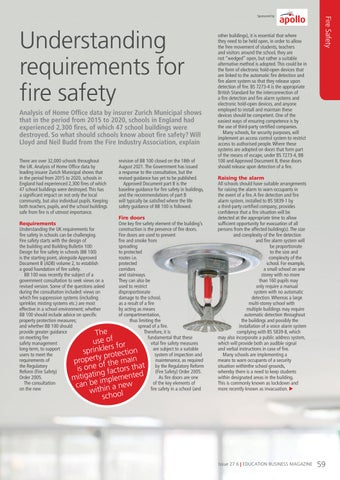Understanding requirements for fire safety Analysis of Home Office data by insurer Zurich Municipal shows that in the period from 2015 to 2020, schools in England had experienced 2,300 fires, of which 47 school buildings were destroyed. So what should schools know about fire safety? Will Lloyd and Neil Budd from the Fire Industry Association, explain There are over 32,000 schools throughout the UK. Analysis of Home Office data by leading insurer Zurich Municipal shows that in the period from 2015 to 2020, schools in England had experienced 2,300 fires of which 47 school buildings were destroyed. This has a significant impact on not only the local community, but also individual pupils. Keeping both teachers, pupils, and the school buildings safe from fire is of utmost importance.
revision of BB 100 closed on the 18th of August 2021. The Government has issued a response to the consultation, but the revised guidance has yet to be published. Approved Document part B is the baseline guidance for fire safety in buildings, and the recommendations of part B will typically be satisfied where the life safety guidance of BB 100 is followed.
Fire doors Requirements One key fire safety element of the building’s Understanding the UK requirements for construction is the presence of fire doors. fire safety in schools can be challenging. Fire doors are used to prevent Fire safety starts with the design of fire and smoke from the building and Building Bulletin 100: spreading Design for fire safety in schools (BB 100) to protected is the starting point, alongside Approved routes i.e. Document B (ADB) volume 2, to establish protected a good foundation of fire safety. corridors BB 100 was recently the subject of a and stairways. government consultation to seek views on a They can also be revised version. Some of the questions asked used to restrict during the consultation included: views on disproportionate which fire suppression systems (including damage to the school, sprinkler, misting systems etc.) are most as a result of a fire effective in a school environment; whether by acting as means BB 100 should include advice on specific of compartmentation, property protection measures; thus limiting the and whether BB 100 should spread of a fire. provide greater guidance Therefore, it is e h T on meeting fire fundamental that these f use o or safety management vital fire safety measures sf r e l long‑term, to support are subject to a suitable k n i r sp ion t c e users to meet the system of inspection and t o r p requirements of maintenance, as required roperty f the main p o the Regulatory by the Regulatory Reform t e a is on g factors th Reform (Fire Safety) (Fire Safety) Order 2005. n i Order 2005. As fire doors are one mitigat implemented e The consultation of the key elements of b n w a c ne on the new fire safety in a school (and ithin a
w
school
other buildings), it is essential that where they need to be held open, in order to allow the free movement of students, teachers and visitors around the school, they are not “wedged” open, but rather a suitable alternative method is adopted. This could be in the form of electronic hold-open devices that are linked to the automatic fire detection and fire alarm system so that they release upon detection of fire. BS 7273-4 is the appropriate British Standard for the interconnection of a fire detection and fire alarm systems and electronic hold-open devices, and anyone employed to install and maintain these devices should be competent. One of the easiest ways of ensuring competence is by the use of third-party certified companies. Many schools, for security purposes, will implement an access control system to restrict access to authorised people. Where these systems are adopted on doors that form part of the means of escape, under BS 7273-4, BB 100 and Approved Document B, these doors should release upon detection of a fire.
Fire Safety
Sponsored by
Raising the alarm All schools should have suitable arrangements for raising the alarm to warn occupants in the event of a fire. A fire detection and fire alarm system, installed to BS 5839-1 by a third‑party certified company, provides confidence that a fire situation will be detected at the appropriate time to allow sufficient opportunity for evacuation of all persons from the affected building(s). The size and complexity of the fire detection and fire alarm system will be proportionate to the size and complexity of the school. For example, a small school on one storey with no more than 160 pupils may only require a manual system with no automatic detection. Whereas a large multi‑storey school with multiple buildings may require automatic detection throughout the buildings and possibly the installation of a voice alarm system complying with BS 5839-8, which may also incorporate a public address system, which will provide both an audible signal and verbal instructions in case of fire. Many schools are implementing a means to warn occupants of a security situation withinthe school grounds, whereby there is a need to keep students within designated areas in the building. This is commonly known as lockdown and more recently known as invacuation. E
Issue 27.6 | EDUCATION BUSINESS MAGAZINE
59














